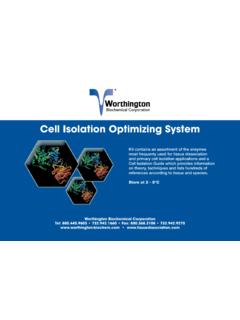Transcription of An Introduction to ENZYMES 122019-v6
1 Introduction to ENZYMES The following has been excerpted from a very popular Worthington publication which was originally published in 1972 as the Manual of Clinical Enzyme Measurements. While some of the presentation may seem somewhat dated, the basic concepts are still helpful for researchers who must use ENZYMES but who have little background in enzymology. Introduction The use of ENZYMES in the diagnosis of disease is one of the important benefits derived from the intensive research in biochemistry since the 1940's. ENZYMES have provided the basis for the field of clinical chemistry. It is, however, only within the recent past few decades that interest in diagnostic enzymology has multiplied. Many methods currently on record in the literature are not in wide use, and there are still large areas of medical research in which the diagnostic potential of enzyme reactions has not been explored at all.
2 This section has been prepared by Worthington Biochemical Corporation as a practical Introduction to enzymology. Because of its close involvement over the years in the theoretical as well as the practical aspects of enzymology, Worthington's knowledge covers a broad spectrum of the subject. Some of this information has been assembled here for the benefit of laboratory personnel. This section summarizes in simple terms the basic theories of enzymology. I. ENZYMES and Life Processes The living cell is the site of tremendous biochemical activity called metabolism. This is the process of chemical and physical change which goes on continually in the living organism. Build-up of new tissue, replacement of old tissue, conversion of food to energy, disposal of waste materials, reproduction - all the activities that we characterize as "life.
3 " This building up and tearing down takes place in the face of an apparent paradox. The greatest majority of these biochemical reactions do not take place spontaneously. The phenomenon of catalysis makes possible biochemical reactions necessary for all life processes. Catalysis is defined as the acceleration of a chemical reaction by some substance which itself undergoes no permanent chemical change. The catalysts of biochemical reactions are ENZYMES and are responsible for bringing about almost all of the chemical reactions in living organisms. Without ENZYMES , these reactions take place at a rate far too slow for the pace of metabolism. The oxidation of a fatty acid to carbon dioxide and water is not a gentle process in a test tube - extremes of pH, high temperatures and corrosive chemicals are required.
4 Yet in the body, such a reaction takes place smoothly and rapidly within a narrow range of pH and temperature. In the laboratory, the average protein must be boiled for about 24 hours in a 20% HCl solution to achieve a complete breakdown. In the body, the breakdown takes place in four hours or less under conditions of mild physiological temperature and pH. It is through attempts at understanding more about enzyme catalysts - what they are, what they do, and how they do it - that many advances in medicine and the life sciences have been brought about. Early Enzyme Discoveries The existence of ENZYMES has been known for well over a century. Some of the earliest studies were performed in 1835 by the Swedish chemist Jon Jakob Berzelius who termed their chemical action catalytic. It was not until 1926, however, that the first enzyme was obtained in pure form, a feat accomplished by James B.
5 Sumner of Cornell University. Sumner was able to isolate and crystallize the enzyme urease from the jack bean. His work was to earn him the 1947 Nobel Prize. John H. Northrop and Wendell M. Stanley of the Rockefeller Institute for Medical Research shared the 1947 Nobel Prize with Sumner. They discovered a complex procedure for isolating pepsin. This precipitation technique devised by Northrop and Stanley has been used to crystallize several ENZYMES . Chemical Nature of ENZYMES All known ENZYMES are proteins. They are high molecular weight compounds made up principally of chains of amino acids linked together by peptide bonds. See Figure 1. ENZYMES can be denatured and precipitated with salts, solvents and other reagents. They have molecular weights ranging from 10,000 to 2,000,000. Many ENZYMES require the presence of other comp ounds - cofactors - before their catalytic activity can be exerted.
6 This entire active complex is referred to as the holoenzyme; , apoenzyme (protein portion) plus the cofactor (coenzyme, prosthetic group or metal-ion-activator) is called the holoenzyme. Apoenzyme + Cofactor = Holoenzyme According to Holum, the cofactor may be: 1. A coenzyme - a non-protein organic substance which is dialyzable, thermostable and loosely attached to the protein part. 2. A prosthetic group - an organic substance which is dialyzable and thermostable which is firmly attached to the protein or apoenzyme portion. 3. A metal-ion-activator - these include K+, Fe++, Fe+ + +, Cu++, Co++, Zn+ +, Mn+ +, Mg+ +, Ca++, and Mo+ + +. Specificity of ENZYMES One of the properties of ENZYMES that makes them so important as diagnostic and research tools is the specificity they exhibit relative to the reactions they catalyze.
7 A few ENZYMES exhibit absolute specificity; that is, they will catalyze only one particular reaction. Other ENZYMES will be specific for a particular type of chemical bond or functional group. In general, there are four distinct types of specificity: 1. Absolute specificity - the enzyme will catalyze only one reaction. 2. Group specificity - the enzyme will act only on molecules that have specific functional groups, such as amino, phosphate and methyl groups. 3. Linkage specificity - the enzyme will act on a particular type of chemical bond regardless of the rest of the molecular structure. 4. Stereochemical specificity - the enzyme will act on a particular steric or optical isomer. Though ENZYMES exhibit great degrees of specificity, cofactors may serve many apoenzymes. For example, nicotinamide adenine dinucleotide (NAD) is a coenzyme for a great number of dehydrogenase reactions in which it acts as a hydrogen acceptor.
8 Among them are the alcohol dehydrogenase, malate dehydrogenase and lactate dehydrogenase reactions. Naming and Classification Except for some of the originally studied ENZYMES such as pepsin, rennin, and trypsin, most enzyme names end in "ase". The International Union of Biochemistry ( ) initiated standards of enzyme nomenclature which recommend that enzyme names indicate both the substrate acted upon and the type of reaction catalyzed. Under this system, the enzyme uricase is called urate: O2 oxidoreductase, while the enzyme glutamic oxaloacetic transaminase (GOT) is called L-aspartate: 2-oxoglutarate aminotransferase. ENZYMES can be classified by the kind of chemical reaction catalyzed. I. Addition or removal of water A. Hydrolases - these include esterases, carbohydrases, nucleases, deaminases, amidases, and proteases B.
9 Hydrases such as fumarase, enolase, aconitase and carbonic anhydrase II. Transfer of electrons A. Oxidases B. Dehydrogenases III. Transfer of a radical A. Transglycosidases - of monosaccharides B. Transphosphorylases and phosphomutases - of a phosphate group C. Transaminases - of amino group D. Transmethylases - of a methyl group E. Transacetylases - of an acetyl group IV. Splitting or forming a C-C bond A. Desmolases V. Changing geometry or structure of a molecule A. Isomerases VI. Joining two molecules through hydrolysis of pyrophosphate bond in ATP or other tri-phosphate A. Ligases II. Enzyme Kinetics Basic Enzyme Reactions ENZYMES are catalysts and increase the speed of a chemical reaction without themselves undergoing any permanent chemical change. They are neither used up in the reaction nor do they appear as reaction products. The basic enzymatic reaction can be represented as follows where E represents the enzyme catalyzing the reaction, S the substrate, the substance being changed, and P the product of the reaction.
10 Energy Levels Chemists have known for almost a century that for most chemical reactions to proceed, some form of energy is needed. They have termed this quantity of energy, "the energy of activation." It is the magnitude of the activation energy which determines just how fast the reaction will proceed. It is believed that ENZYMES lower the activation energy for the reaction they are catalyzing. Figure 3 illustrates this concept. The enzyme is thought to reduce the "path" of the reaction. This shortened path would require less energy for each molecule of substrate converted to product. Given a total amount of available energy, more molecules of substrate would be converted when the enzyme is present (the shortened "path") than when it is absent. Hence, the reaction is said to go faster in a given period of time.




